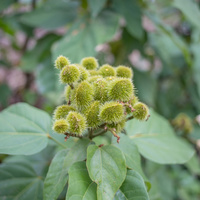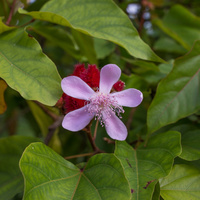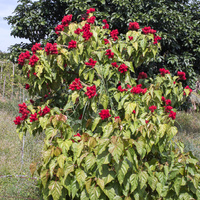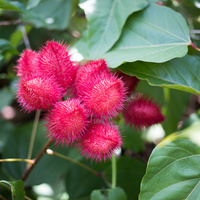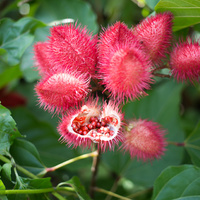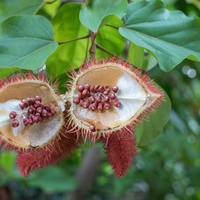Common name: Annatto
Other common names: Anato, Annato, Arnatto, Lipstick tree
Description
Annatto seed are the source of a natural colourant used in food, cosmetics, pharmaceuticals and household consumables.
A native of tropical America, its natural range extends from near Mazatlán, on Mexico's Pacific coast, south through Central and South America, to Mato Grosso do Sul, in Brazil.
It is a low-branching shrub or small tree 2 to 8 m (7 to 26 ft) tall, occasionally with a single trunk up to 10 cm (4 in) in diameter, though more typically with multiple stems in a V-shape, forming a wide-spreading crown. The bark is dark brown and dotted with wart-like pores known as lenticels. When wounded, it oozes an orange coloured sap, particularly from older trees.
Leaves are heart-shaped, 10 to 20 cm (4 to 8 in) long, dark glossy green on top, greyish underneath, occasionally with burgundy veining, and stalks up to 7.5 cm (3 in) long. Alternately arranged along the stems at the ends of the branches, they remain on the plant in all seasons.
Flowers are up to 5 cm (2 in) wide with four to seven white or pale pink petals. They arise in clusters of up to fifty at the ends of the branches and are perfect, with both female and male parts but need insects to pollinate them.
Fertilised flowers develop into egg-shaped seedpods up to 5 cm (2 in) long covered in coarse, bristle-like hairs. Green when young, they become bright pink or red (eventually dark brown when dry), then split open into halves exposing tiny triangular-shaped seed. Each with a thin, orange-red coating of pulp.
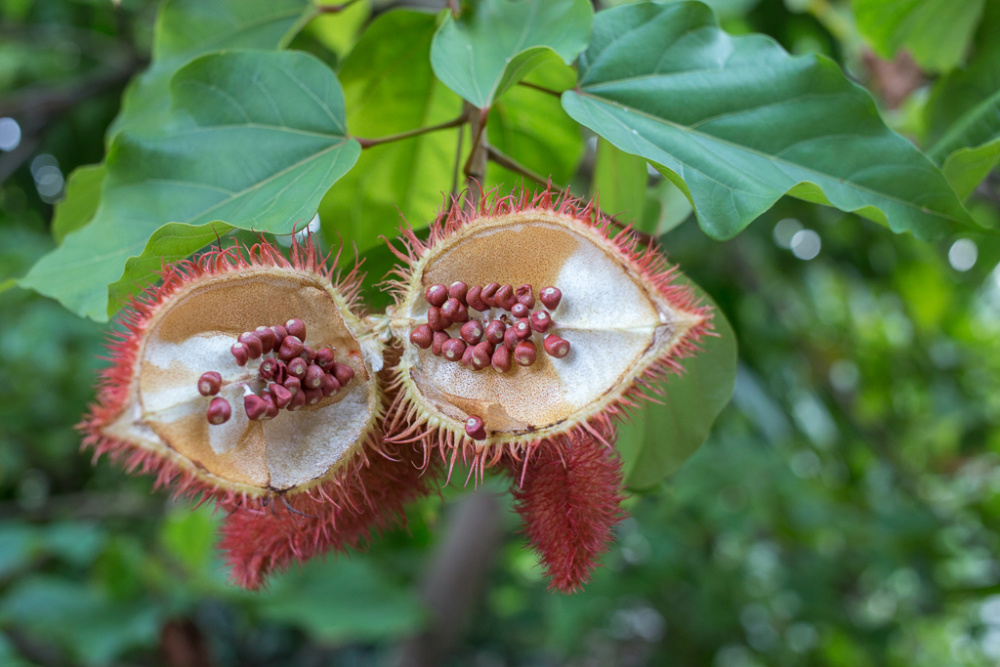
Annatto seed inside split seedpod
Use
The thin layer of pulp covering the seed is one of the world's most widely used natural colourants, prized for its rich tones of yellow and orange, as well as its subtle flavour. It is extracted by grinding and washing the seed, then filtering, drying and pressing it into cakes.
Annatto seed pulp has a long history of use by the dairy industry to give butter, margarine and cheeses such as cheddar their rich yellow or orange colour. It is also commonly used as a colourant in bakery goods, smoked fish, meat and meat products, including sausage casings, salad oil, popcorn oil, packaged soups, sauces and relishes.
When heated in cooking oil, the seed infuses a deep orange colour. The infused oil can then be kept and used for frying, especially in Guatemala and Mexico, to colour meat, fish and rice dishes and impart a subtle, earthy flavour.
Introduced to the Philippines by the Spanish, the seeds are now closely associated with Filipino cuisine, used in various rice, chicken, beef and shrimp dishes. It is the closest substitute for saffron, used for adding colour and flavour to classic European dishes such as Bouillabaisse, the famous French seafood dish, and Paella, the popular rice, seafood and meat dish from Spain.
The seed have a dry weight crude protein content of about 7%. Sometimes added to poultry rations (feed), they give the meat and eggs colour, increasing their yellow colour intensity, especially the egg yolks.
Non-food uses of the pulp include dyes and colours developed for the cosmetic and pharmaceutical industries, such as lipstick, nail polish, hair colouring, and colour formulations designed for coating pills and tablets. It is also a colourant in furniture polish, floor wax, soap, wood stain and shoe polish.
In recent times, trends towards the use of natural colourants, the increasing restrictions on the use of some synthetic dyes and the relative instability of most other natural dyes in the yellow to red spectrum has led to an increase in the demand and production of annatto pulp.
Health use
Annatto seed are one of the richest sources of tocotrienols, a group of chemicals that are part of the vitamin E family. Some studies suggest that tocotrienols may help fight free radical damage to the gastrointestinal system, reducing cancer risk.
Climate
Annatto grows naturally in moderately humid to humid subtropical and tropical climates, generally frost-free areas with annual lows of 16 to 25°C, annual highs of 27 to 35°C, annual rainfall of 900 to 4500 mm and a dry season of 5 months or less.
Growing
New plants are usually raised from seed or cuttings, but cuttings are preferred because they flower and fruit sooner than seed-grown plants do.
Performs best on rich, free-draining clay and loam soils of a moderately acid to slightly alkaline nature, generally with a pH of 5.0 to 7.5, and on sites with full to partial sun exposure.
The mature seedpods should be harvested before they have opened on the tree to avoid the seed becoming exposed and damp, which reduces their quality.
Problem features
It is widely introduced and cultivated throughout the tropics and subtropics and is naturalised in many countries. It is assessed as a low weed risk for Hawaii, by the Hawaii Pacific Weed Risk Assessment (HPWRA) project. However, in Australia, it is reported as having escaped cultivation and a weed of the natural environment.
Where it grows
References
Books
-
Adams, C. D. 1972, Flowering plants of Jamaica, University of the West Indies, Mona, Greater Kingston
-
Attokaran, M. 2011, Natural food flavors and colorants, Institute of Food Technologists, Wiley-Blackwell Publishing, Oxfordshire
-
Brady, G. S. & Clauser, H. R & Vaccari, J. A. 2002, Materials handbook : an encyclopedia for managers, technical professionals, purchasing and production managers, technicians and supervisors, 15th ed., McGraw-Hill, New York
-
Cassidy, F. G. & Le Page, R. B. 1980, Dictionary of Jamaican English, 2nd ed., Cambridge University Press, Cambridgeshire
-
Chevallier, A. 2000, Encyclopedia of herbal medicine, 2nd American ed., Dorling Kindersley, New York
-
Dean, J. 2010, Wild Color : the complete guide to making and using natural dyes (Revised and updated edition), Watson-Guptill Publishing, New York
-
Farooqi, A. A. & Sreeramu, B. S. 2004, Cultivation of medicinal and aromatic crops, Hyderabad University Press, Hyderabad
-
Francis, J. K. 2004, Wildland shrubs of the United States and its territories: Thamnic descriptions, U.S. Department of Agriculture, Forest Service, International Institute of Tropical Forestry, Río Piedras, San Juan, Puerto Rico & Rocky Mountain Research Station, Fort Collins, Colorodo
-
Francis, J. K. and Liogier, H. A. 1991, Naturalized exotic tree species in Puerto Rico, General technical report SO-82, USDA Forest Service, Southern Forest Experiment Station, New Orleans
-
Gohl, B. 1981, Tropical Feeds : feed information summaries and nutritive values (Revised edition), Food and Agriculture Organization of the United Nations (FAO), Rome
-
Green, C. L. 1995, Natural colourants and dyestuffs : a review of production, markets and development potential, Food and Agriculture Organization of the United Nations (FAO), Rome
-
Jansen, P.C.M. & Cardon, D. (Editors) 2005, Plant Resources of Tropical Africa, Volume 3 : Dyes and tannins, PROTA Foundation, Backhuys Publishers, Leiden
-
Jensen, M. 1999, Trees commonly cultivated in Southeast Asia : an illustrated field guide, 2nd ed., Food and Agricultural Organisation of the United Nations (FAO) Regional Office for Asia and the Pacific (RAP), Bangkok
-
Khan, I. A. & Abourashed, E. A. 2010, Leung's encyclopedia of common natural ingredients : used in food, drugs and cosmetics, 3rd edition, Wiley Publishing, Hoboken, New Jersey
-
Krishen, P. 2006, Trees of Delhi : a field guide, Dorling Kindersley Publishers, Delhi
-
Krohn-Ching, Val 1980, Hawaii dye plants and dye recipes, University Press of Hawaii, Honolulu
-
Little, E. L. et al. 1964 and 1974, Common trees of Puerto Rico and the Virgin Islands (2 volumes), Forest Service, U.S. Department of Agriculture (USDA), Washington D.C.
-
Lorenzi, H. 2002, Brazilian trees : a guide to the identification and cultivation of Brazilian native trees. Vol. 1, 4. ed, Instituto Plantarum de Estudos da Flora, Nova Odessa, Sao Paulo
-
Menninger, E. A. 1977, Edible nuts of the world, Horticultural Books, Stuart, Florida
-
Parrotta, J. A. 2001, Healing plants of peninsular India, CABI Publishing, Wallingford, Oxfordshire
-
Perry, F. & Hay, R. 1982, A field guide to tropical and subtropical plants, Van Nostrand Reinhold Company, New York
-
Raichlen, S. 1993, Miami spice : the new Florida cuisine, Workman Publishing Company, New York
-
Randall, R. P. 2002, A global compendium of weeds, R.G. and F.J. Richardson Press, Melbourne
-
Record, S. J. & Hess, R. W., 1972, Timbers of the New World, Yale University Press, New Haven, Connecticut & Arno Press, New York
-
Seidemann, J. 2005, World spice plants: economic usage botany taxonomy, Springer-Verlag, Berlin
-
Sterling, D. 2014, Yucatán : recipes from a culinary expedition, First edition, Austin, TX University of Texas Press
-
Vázquez, Y. C. 1999, Potentially valuable Mexican trees for ecological restoration and reforestation, Institute of Ecology, Database SNIB-REMIB-CONABIO, Project J084, Mexico
-
Winter, R. 2009, A consumer's dictionary of cosmetic ingredients : complete information about the harmful and desirable ingredients found in cosmetics and cosmeceuticals, 7th ed, Three Rivers Press, New York
Articles, Journals, Reports and Working Papers
-
Morton, J.F. 1964, Honeybee Plants of South Florida, Proceedings of the Florida State Horticultural Society, Vol 77:415-436.
